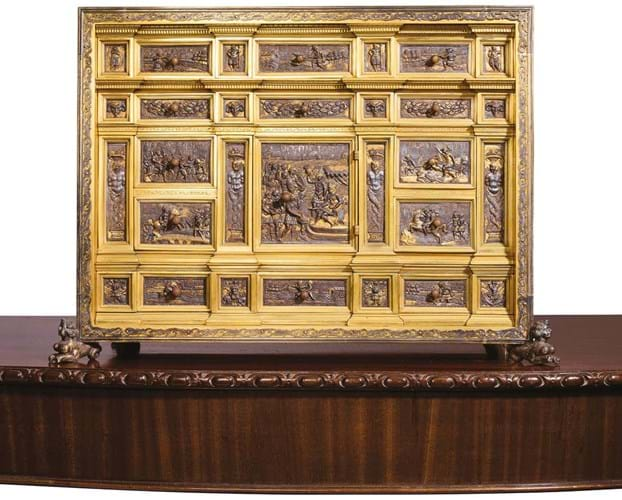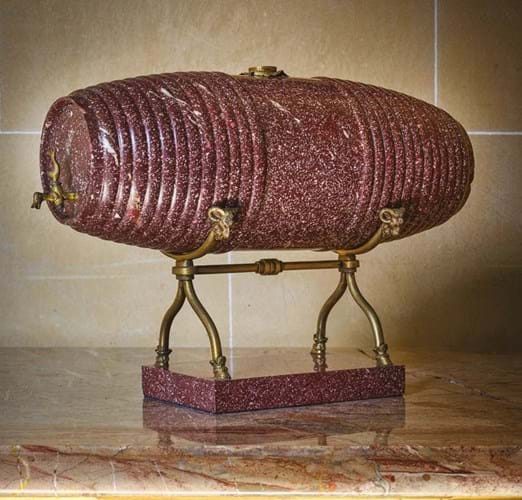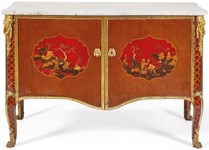
A c.1810 micromosaic and Siena marble centre table – £160,000 at the Exbury House sale at Woolley & Wallis.
.
The Rothschilds’ rich and powerful contemporaries in the US such as the Vanderbilts, Astors and Rockefellers, embraced a similar aesthetic as did post-war trend-setters such as Yves St Laurent and Robert Denning. In truth, somewhere on the globe opulence is in fashion.
International and home bidders were out in force at the Woolley & Wallis (25% buyer’s premium) sale of contents from Exbury House, consigned by the Rothschild Family Trust as the Hampshire stately home of the banking family undergoes internal redesign.
Following in the wake of some welcome consignments sold piecemeal last year, a 231-lot sale titled Exbury House: Le Goût Rothschild on October 5 brought a hammer total of £1.12m.
‘Rafaelli table’
Furniture included the best-seller, a c.1810 micromosaic and Siena marble centre table attributed to Giacomo Raffaelli (1753-1836) and his Rome or Milan workshop.
The 3ft 2in (96cm) diameter revolving top was inlaid with bands of scrolls and flowers and centred with a quarter-veneered Egyptian alabaster and lapis lazuli roundel.
The 1918 probate of the estate of Alfred de Rothschild (1842-1918) valued it at £80. Recent sales of micromosaic tables attributed to Raffaelli – acknowledged master of the genre – include one at Christie’s in June 2021 which made £80,000.
The Salisbury star, pitched at £40,000-60,000, sold to a European dealer, probably bidding for a collector, at £160,000.
A near pair of c.1850-60, Louis XVI-style rosewood and ormolu-mounted centre tables was attributed to eminent Paris cabinetmaker Louis- Auguste-Alfred Beurdeley.
Each had 4ft 3in (1.32m) wide rectangular Sarrancolin Opera tops, one mounted with two 17th century Florentine pietra dura plaques inlaid with figures after Callot, the other mounted with a pair of micromosaic plaques.
Against a £20,000-30,000 estimate, the tables went to the London trade at £50,000.
A c.1755-60 ormolu-mounted kingwood serpentine bombé commode with a rouge griotte marble top was attributed to Gilles Joubert (1689-1755) who supplied furniture to Louis XV’s court. The 4ft 1in wide (1.25m) piece headed to a UK private buyer within estimate at £28,000.
A top table casket
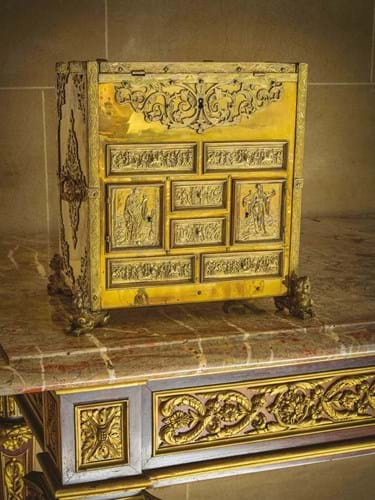
A 16th or 17th century gilt copper table cabinet – £25,000 at the Exbury House sale at Woolley & Wallis.
Metalware included a late 16th century gilt-copper table cabinet probably made in Augsburg.
The 12in (31cm) tall casket’s hinged top engraved with a scene in Eden opened to reveal five drawers decorated in relief with panels of classical scenes and two doors decorated with maidens in a landscape.
The 1918 probate had valued it at £40. At Salisbury it more than doubled top expectations, selling to an international collector at £25,000.
The biggest surprises of the day, however, came among the damascened steel and gilt bronze embossed parade shields created by 19th century north Italian craftsmen reproducing the ones their 16th century Milanese forebears made for nobles to flaunt their wealth and valour.
Of the four on offer – collectively estimated at £3200-4800 and making a total of £72,800 – the best was the 2ft 1in (62cm) diameter shield illustrated above with four oval panels decorated in relief with the suitably gory Old Testament stories.

A 19th century Italian steel and gilt-bronze reproduction of a 16th century shield – £48,000 at the Exbury House sale at Woolley & Wallis.
Estimated at £800-1200, it sold to a London dealer at £48,000. The others were shared between a European dealer and two other London dealers.
A 19th century reproduction was the steel and gilt bronze armourer’s cabinet also pictured here, decorated to the cupboard door and 11 drawers with scenes of Roman military history, satyr masks, and war trophies.
On sphinx supports, the 16½in x 2ft (42 x 60cm) cabinet on a later 2ft 8in (81cm) high French ‘Japonisme’ stand went to an international collector at £40,000 against a £10,000-15,000 estimate.
Bright lights
Lighting material can give full rein to extravagantly inclined designers but it was two of the more restrained items, bought by UK collectors, which led the five examples at five figures from Exbury House.
One was a set of four early 19th century French ormolu Louis XVI-style wall lights.
After a model by bronziers Edmé- Jean Gallien and Pierre Bureaux, each featured three candle arms shaped as hunting horns issuing from a backplate cast with oak leaves and acorns. The 3ft 2in (98cm) tall lights which had been later drilled for electricity more than doubled the top estimate at £33,000.

Louis XVI rock crystal and ormolu candlesticks – £30,000 at the Exbury House sale at Woolley & Wallis.
Going further beyond estimate was a period work: a pair of Louis XVI rock crystal and ormolu candlesticks. The 10¼in (26cm) tall sticks quadrupled expectations at £30,000.
Porcelain was led, almost inevitably, by a piece from China, while the top-selling European lot could be included among the lighting. This was a pair of c.1820-30 ormolu and Sèvres vases after the model by the court gilder Pierre Gouthière (1732-1813), later fitted with lily flower and leaf candelabra branches then fitted for electricity. The royal blue ovoid bodies had entwined serpent handles with stiff leaf decoration and a band of laurel to the spreading feet.
Standing 3ft 11in (1.10m) all and estimated at £10,000-15,000, the pair sold to a Continental bidder at £22,000.
German soldier duo

Late 16th or early 17th century silver gilt German model soldiers – £21,000 at the Exbury House sale at Woolley & Wallis.
Silver, as was the case with furniture, included many solid, practical English items generally selling above estimate in three and four figures.
All were outshone by a pair of German, probably Augsburg, silver-gilt model soldiers. The 5in (12.5cm) tall, late 16th/early 17th century, kneeling soldiers with reticulated hands sold within estimate to a UK collector at £21,000.
Decorative value on other lots with no practical application was the sole attraction of a number of sale highlights.
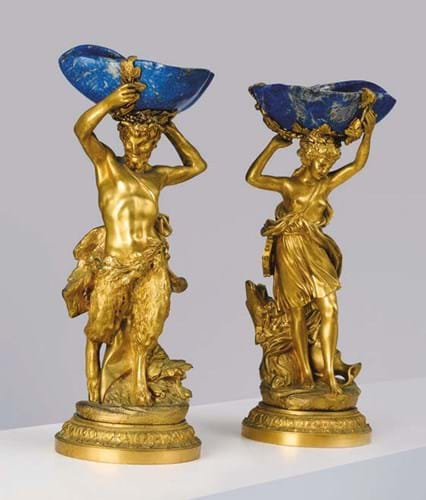
Pair of tazze comprising lapis lazuli bowls and ormolu figures – £20,000 at the Exbury House sale at Woolley & Wallis.
An example was a French amalgamation of early 17th century lapis lazuli bowls mounted with 18th/19th century ormolu figures of a satyr and bacchante in the manner of the sculptor Clodion (Claude Michel 1738-1814) to create a pair of tazze.
The 14in (36cm) tall pair doubled lower expectations, going to a London dealer, probably bidding for a collector, at £20,000.
A mid-19th century model of a wine barrel, carved from Egyptian red porphyry in the manner of Benedetto Boschetti (1820-79) or Giacomo Raffaelli was engraved with the arms of the noble Visconti family.
The 18in long (46.5cm) barrel stood on a porphyry and gilt bronze stand with ram supports and engraved Ioannes Card Visconti and Milano Anno 1340, suggesting it was made in 1840 for the celebrations marking the family’s 500 years of eminence in the city.
Pitched at £4000-6000, it sold to a UK collector at £19,000.
Less exotic, being made of lead, but quadrupling expectations was a pair of c.1730-40 campana urn-shaped finials. Standing 3ft high x 19in wide (90 x 49cm), they were decorated with swags of fruit and leaves suspended from rings. With cone finials, stiff-leave-decorated stems and square feet, the pair sold to a UK collector at £11,000.



